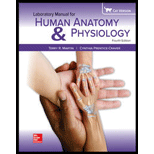
Laboratory Manual for Human Anatomy & Physiology (Cat Version)
4th Edition
ISBN: 9781259864612
Author: Martin
Publisher: MCGRAW-HILL HIGHER EDUCATION
expand_more
expand_more
format_list_bulleted
Question
Chapter 12, Problem 1.1CT
Summary Introduction
To analyze:
The process by which the osteocytes obtain nutrients and eliminate waste.
Introduction:
Osteocytes aremature bone cell formed when an osteoblast becomes surrounded by its own matrix and entrapped in a cavity called lacuna.
Expert Solution & Answer
Want to see the full answer?
Check out a sample textbook solution
Students have asked these similar questions
Give only the mode of inheritance consistent with all three pedigrees and only two reasons that support this, nothing more, (it shouldn't take too long)
O
Describe the principle of homeostasis.
Chapter 12 Solutions
Laboratory Manual for Human Anatomy & Physiology (Cat Version)
Ch. 12 - Which of the following tissues is not part of a...Ch. 12 - The organic matter of living bone includes calcium...Ch. 12 - The _____________ is an example of a sesamoid...Ch. 12 - The epiphyseal plate represents the ends of the...Ch. 12 - The central canal of a bone osteon contains blood...Ch. 12 - A _____________ is an example of an irregular...Ch. 12 - A femur includes both compact and spongy bone...Ch. 12 - Prob. 8PLCh. 12 - Trabeculae are structural characteristics of...Ch. 12 - Prob. 1.1CT
Ch. 12 - A bone that has a wide surface is classified as...Ch. 12 - The bones of the wrist are examples of...Ch. 12 - The bone of the thigh is an example of a(an)...Ch. 12 - Vertebrae are examples of ___________ bones.Ch. 12 - The patella (kneecap) is an example of a special...Ch. 12 - The bones of the skull that form a protective...Ch. 12 - Distinguish between the epiphysis and the...Ch. 12 - Describe where cartilage is found on the surface...Ch. 12 - Why doesn't the periosteum cover the articular...Ch. 12 - Distinguish between the locations and tissues...Ch. 12 - What structural differences did you note between...Ch. 12 - How are these structural differences related to...Ch. 12 - From your observations, how does the marrow in the...Ch. 12 - The humerus is the proximal bone of an upper limb;...Ch. 12 - FIGURE 12.9 Label the structures of this long...Ch. 12 - FIGURE 12.10 Identify the structures indicated in...Ch. 12 - FIGURE 12.11 Label the structures associated with...Ch. 12 - FIGURE 12.12 Label the structures of compact bone...
Knowledge Booster
Similar questions
- Explain how the hormones of the glands listed below travel around the body to target organs and tissues : Pituitary gland Hypothalamus Thyroid Parathyroid Adrenal Pineal Pancreas(islets of langerhans) Gonads (testes and ovaries) Placentaarrow_forwardWhat are the functions of the hormones produced in the glands listed below: Pituitary gland Hypothalamus Thyroid Parathyroid Adrenal Pineal Pancreas(islets of langerhans) Gonads (testes and ovaries) Placentaarrow_forwardDescribe the hormones produced in the glands listed below: Pituitary gland Hypothalamus Thyroid Parathyroid Adrenal Pineal Pancreas(islets of langerhans) Gonads (testes and ovaries) Placentaarrow_forward
- Please help me calculate drug dosage from the following information: Patient weight: 35 pounds, so 15.9 kilograms (got this by dividing 35 pounds by 2.2 kilograms) Drug dose: 0.05mg/kg Drug concentration: 2mg/mLarrow_forwardA 25-year-old woman presents to the emergency department with a 2-day history of fever, chills, severe headache, and confusion. She recently returned from a trip to sub-Saharan Africa, where she did not take malaria prophylaxis. On examination, she is febrile (39.8°C/103.6°F) and hypotensive. Laboratory studies reveal hemoglobin of 8.0 g/dL, platelet count of 50,000/μL, and evidence of hemoglobinuria. A peripheral blood smear shows ring forms and banana-shaped gametocytes. Which of the following Plasmodium species is most likely responsible for her severe symptoms? A. Plasmodium vivax B. Plasmodium ovale C. Plasmodium malariae D. Plasmodium falciparumarrow_forwardStandard Concentration (caffeine) mg/L Absorbance Reading 10 0.322 20 0.697 40 1.535 60 2.520 80 3.100arrow_forward
- please draw in the answers, thank youarrow_forwarda. On this first grid, assume that the DNA and RNA templates are read left to right. DNA DNA mRNA codon tRNA anticodon polypeptide _strand strand C с A T G A U G C A TRP b. Now do this AGAIN assuming that the DNA and RNA templates are read right to left. DNA DNA strand strand C mRNA codon tRNA anticodon polypeptide 0 A T G A U G с A TRParrow_forwardplease answer all question below with the following answer choice, thank you!arrow_forward
arrow_back_ios
SEE MORE QUESTIONS
arrow_forward_ios
Recommended textbooks for you
 Human Biology (MindTap Course List)BiologyISBN:9781305112100Author:Cecie Starr, Beverly McMillanPublisher:Cengage Learning
Human Biology (MindTap Course List)BiologyISBN:9781305112100Author:Cecie Starr, Beverly McMillanPublisher:Cengage Learning Medical Terminology for Health Professions, Spira...Health & NutritionISBN:9781305634350Author:Ann Ehrlich, Carol L. Schroeder, Laura Ehrlich, Katrina A. SchroederPublisher:Cengage Learning
Medical Terminology for Health Professions, Spira...Health & NutritionISBN:9781305634350Author:Ann Ehrlich, Carol L. Schroeder, Laura Ehrlich, Katrina A. SchroederPublisher:Cengage Learning Human Physiology: From Cells to Systems (MindTap ...BiologyISBN:9781285866932Author:Lauralee SherwoodPublisher:Cengage Learning
Human Physiology: From Cells to Systems (MindTap ...BiologyISBN:9781285866932Author:Lauralee SherwoodPublisher:Cengage Learning

Human Biology (MindTap Course List)
Biology
ISBN:9781305112100
Author:Cecie Starr, Beverly McMillan
Publisher:Cengage Learning


Medical Terminology for Health Professions, Spira...
Health & Nutrition
ISBN:9781305634350
Author:Ann Ehrlich, Carol L. Schroeder, Laura Ehrlich, Katrina A. Schroeder
Publisher:Cengage Learning

Human Physiology: From Cells to Systems (MindTap ...
Biology
ISBN:9781285866932
Author:Lauralee Sherwood
Publisher:Cengage Learning

